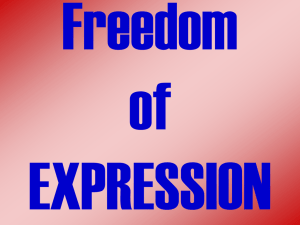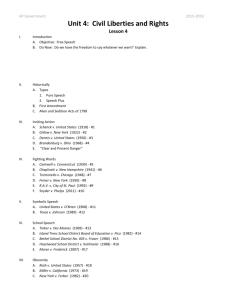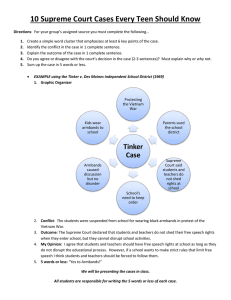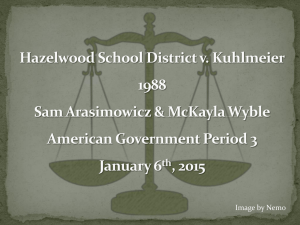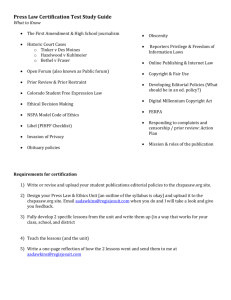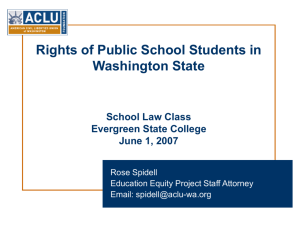PowerPoint - Lake County Schools
advertisement
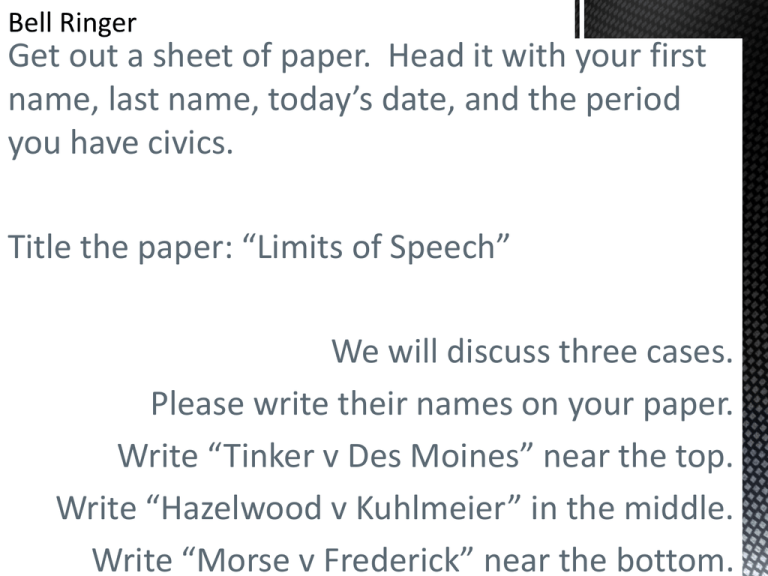
Get out a sheet of paper. Head it with your first name, last name, today’s date, and the period you have civics. Title the paper: “Limits of Speech” We will discuss three cases. Please write their names on your paper. Write “Tinker v Des Moines” near the top. Write “Hazelwood v Kuhlmeier” in the middle. Write “Morse v Frederick” near the bottom. - by the end of this lesson: you should be able to recognize that rights are protected, but not unlimited you should be able to examine rationales for limited individual rights you should be able to use scenarios to examine the impact of limits on individual rights on social behavior you should be able to examine the role of the judicial branch of government in protecting individual rights Hazelwood v Kuhlmeier Morse v Frederick In December 1965, a group of students in Des Moines held a meeting in the home of 16-year-old Christopher Eckhardt to plan a public showing of their support for a truce in the Vietnam war. They decided to wear black armbands throughout the holiday season and to fast on December 16 and New Year's Eve. The principals of the Des Moines school learned of the plan and met on December 14 to create a policy that stated that any student wearing an armband would be asked to remove it, with refusal to do so resulting in suspension. On December 16, Mary Beth Tinker and Christopher Eckhardt wore their armbands to school and were sent home. The following day, John Tinker did the same with the same result. The students did not return to school until after New Year's Day, the planned end of the protest. Through their parents, the students sued the school district for violating the students' right of expression and sought an injunction to prevent the school district from disciplining the students. The district court dismissed the case and held that the school district's actions were reasonable to uphold school discipline. The U.S. Court of Appeals for the Eighth Circuit affirmed the decision without opinion. This case’s question: Does a prohibition against the wearing of armbands in public school, as a form of symbolic protest, violate the students' freedom of speech protections guaranteed by the First Amendment? Does a prohibition against the wearing of armbands in public school, as a form of symbolic protest, violate the students' freedom of speech protections guaranteed by the First Amendment? In a 7-2 opinion, the Supreme Court held that the armbands represented pure speech that is entirely separate from the actions or conduct of those participating in it. The Court also held that the students do not lose the First Amendment rights to freedom of speech when they stepped onto school property. In order to justify the suppression of speech, the school officials must be able to prove that the conduct in question would cause material and substantial disruption with the operation of the school. In this case, the school district's actions evidently stemmed from a fear of possible disruption rather than any actual interference. Fear of disruption is not enough reason to take rights away. Tinker v. Des Moines Morse v Frederick The Spectrum, the school-sponsored newspaper of Hazelwood East High School, was written and edited by students. In May 1983, Robert E. Reynolds, the school principal, received the pages proofs for the May 13 issue. Reynolds found two of the articles in the issue to be inappropriate, and ordered that the pages on which the articles appeared be withheld from publication. The first article he found to be inappropriate was about pregnant students. The article described the students. Even though their names were not given out, the principal was afraid that readers would be able to figure out who the pregnant students were. The second article that he found inappropriate was about divorce. An interviewed student talked about how her divorced father went out too much and didn’t spend enough time with his family. The father did not get a chance to tell his side of the story, so the principal thought the article was unfair. Cathy Kuhlmeier and two other former Hazelwood East students brought the case to court. This case’s question: Did the principal's deletion of the articles violate the students' rights under the First Amendment? Did the principal's deletion of the articles violate the students' rights under the First Amendment? In a 5-3 ruling, the Supreme Court decided that the students’ rights had not been violated. Schools are not required to promote particular types of student speech. If the principal has any good educational reason to limit student speech, then the principal is allowed to limit student speech. Tinker v. Des Moines Hazelwood v Kuhlmeier For this case, we will listen to the Chief Justice of the Supreme Court read the decision. The first part of what he says will summarize the facts of the case. I will ask you to summarize the summary. You may need to take notes. John G. Roberts, Jr.: I have the opinion of the court in case 06-278, Morse versus Fredrick. On January 24, 2002 the Olympic Torch Relay was scheduled pass through Juneau, Alaska. The torchbearers were to proceed along the street in front of Juneau Douglas High School while school was in session. The principal decided to allow students to leave class to observe the relay as an official school event. Teachers and school administrators were on hand monitor the event. John G. Roberts, Jr.: Respondent Joseph Fredrick the senior was late to school that day when he arrived he joined his friends across the street from the school to watch the event. As the torchbearers and camera crews passed by Fredrick and his friends unfurled a 14 foot banner bearing the phrase “Bong Hits 4 Jesus.” Their goal, they later said, was to get on television. The large banner was easily readable by the students on the other side of the street. John G. Roberts, Jr.: Deborah Morse, the high school principal, saw the sign and immediately crossed the street and demanded that it be taken down. Everyone but Fredrick complied. Morse confiscated the banner and told Fredrick to report to her office where she suspended him for 10 days. Fredrick sued the principal and the school board claiming a violation of his First Amendment rights. In one sentence, please summarize what you know about the case so far. John G. Roberts, Jr.: The District Court found no First Amendment violation but the Court of Appeals for the Ninth Circuit reversed. It held that the principal’s actions violated the First Amendment and that Fredrick could sue the principal for damages and injunctive relief. We granted certiorari to review that decision. We began with two preliminary matters. First, we conclude that the viewing of the relay by the students was a school event and that our school-speech precedents therefore applied. John G. Roberts, Jr.: The relay occurred during normal school hours. It was sanctioned by Morse as an approved event and the district’s student conduct rules expressly applied. Teachers and administrators were among the students and were charged with supervising them. Under these circumstances, Fredrick cannot claim that he was not at school. John G. Roberts, Jr.: Second, we agree with Morse that those who view the banner would understand it to be advocating and promoting illegal drug use. The words on the banner could be taken as an invitation to smoke marijuana or as a celebration of drug use. The words bear no political or religious meaning and Fredrick does not claim that they do. But to some of the words might mean nothing at all, Principal Morse was not required to ignore the banners undeniable reference to illegal drugs. John G. Roberts, Jr.: The question before us then is whether a principal can restrict student’s speech at a school event when that speech is reasonably viewed as promoting illegal drug use. In your opinion, can a principal limit student off campus speech if it seems to promote illegal activity like drug use? Answer with “Yes, because ____” or “No, because ____.” John G. Roberts, Jr.: We hold that she may. Over the past four decades we have decided three leading studentspeech cases. In the first, the Tinker case we held that the students had the right to wear black arm bands to school in non-disruptive protest of the Vietnam War. In the other two cases Fraser and Kuhlmeier, we ruled against the students. John G. Roberts, Jr.: But each of these cases recognized two things. First, students do not shed their First Amendments rights at the school-house gate. Second, the nature of those rights has to be accessed in light of the special characteristics of the school environment. The rights of students at school are not the same as the rights of adults in the community at large. John G. Roberts, Jr.: In another line of cases we have repeatedly held that deterring drug use by school children is an extremely important interest one recognize by all branches of government not to mention thousands of school boards across the country. In this case, the Juneau School District had an express policy prohibiting expression advocating the use of substances illegal for minors. Based on the special characteristics of the school environment and the government interest in stopping student drug abuse we conclude that schools may restrict student’s expression promoting such abuse. John G. Roberts, Jr.: School principals have a difficult job and a widely important one. When Fredrick suddenly and unexpectedly unfurled his banner Morse had to decide to act or not act on the spot. It was reasonable for her to conclude that the banner promoted illegal drug use in violation of the establish school policy and that failing to act would send a powerful message to the students entrusted to her care including Fredrick about how serious the school really was about the dangers of illegal drug use. The First Amendment does not require schools to tolerate at school events student expression that contributes those dangers. On the back of your paper, write your name again. Title this paper “04 MvF W I R”. Write a well-crafted argumentative response. Well-crafted means your sentences fit together into a paragraph instead of jumping around. Informative means facts should come from the documents; your opinions are not required. Response means you answer the prompt; don’t just write what you feel like writing. On the back of your paper, write your name again. Title this paper “04 MvF W I R”. Write a well-crafted argumentative response. Well-crafted means your sentences fit together into a paragraph instead of jumping around. Informative means facts should come from the documents; your opinions are not required. Response means you answer the prompt; don’t just write what you feel like writing. Explain two ways that your free speech is limited as a student. Make sure you mention what court case that each limit comes from. Prompt: Pass your Writing Prompt paper all the way back and all the way right.

